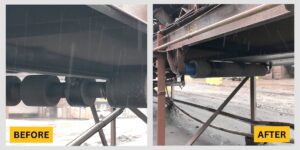Success Story: Solving Belt Tracking Issues with Customized Return Rollers
Problem Summary
A steel plant in the Midwestern United States faced a significant challenge with a 3,000-foot-long coke belt conveyor. Plagued with a cupped belt and failing return rollers, the system suffered persistent tracking issues, causing considerable damage to the belt.
The belt frequently became stuck in the disc return rollers, rendering the return trainers ineffective. Once wedged between the discs, the belt could not self-correct, leading to recurring downtime, frequent belt replacements, and increased frustration for the maintenance team.
The problem threatened operational efficiency and increased costs related to belt and roller replacements.
Benetech Solution
Recognizing the complexity of the issue, Benetech engineered a solution tailored to the plant’s specific needs. The problematic disc return rollers were replaced with flat urethane lagged rollers. The rollers were customized to accommodate the conveyor’s wider-than-standard frame, ensuring a precise fit.
To further enhance performance, the new rollers were equipped with ½-inch lagging, providing superior grip for improved belt stability and tracking.
Benetech products included, but were not limited to:
- Return Rollers – Designed to CEMA standards, Benetech return idlers efficiently guide belts back to the tail pulley to reduce belt wear and improve tracking. They are available with standard or wide base frames, and can accommodate any belt width and troughing angle. To meet this specific plant’s needs, custom options such as wider frames and ½-inch lagging were used.
Successful Results
The replacement of the disc rollers with the customized flat urethane lagged rollers achieved remarkable improvements. The belt now lays flatter and no longer becomes stuck between rollers, significantly enhancing its receptiveness to tracking. Maintenance teams observed a dramatic reduction in roller replacements and belt damage, leading to improved system reliability and reduced operational disruptions.
The solution not only resolved the technical issue but also boosted the morale of the maintenance team. With the repetitive task of replacing damaged rollers eliminated, the maintenance team could dedicate their efforts to other critical plant operations, enhancing overall efficiency and boosting workforce morale.
As a result of this project’s success, the plant plans to replace tracking rollers throughout its facility and stock additional rollers on-site.
- Reduced expenses on belt and return roller replacement, avoiding frequent repairs
- Maintenance staff experienced greater job satisfaction, alleviating frustration from repetitive failures
- Eliminated severe belt mistracking
- Decreased clean-up time and cost
- Reduced safety hazards


